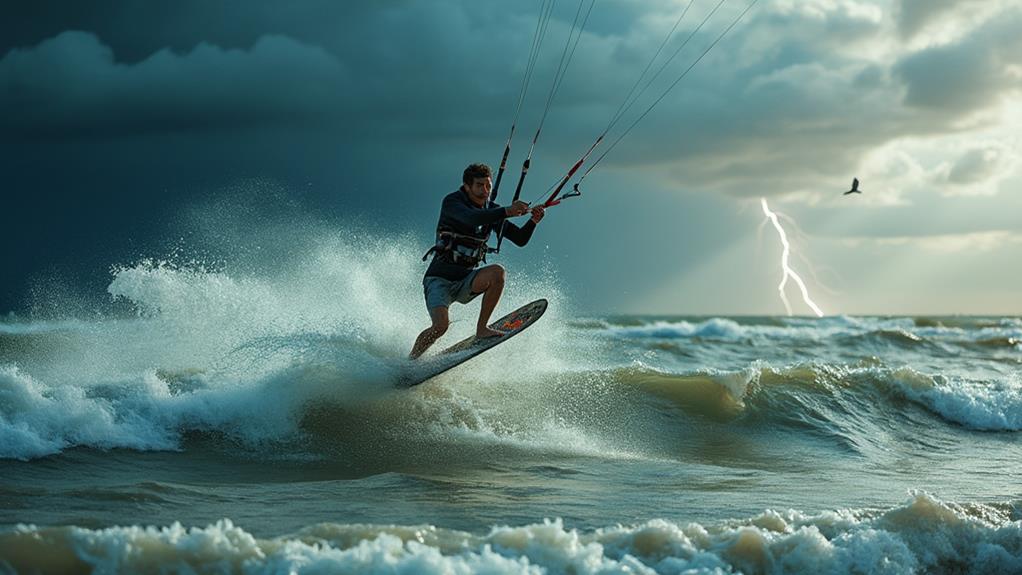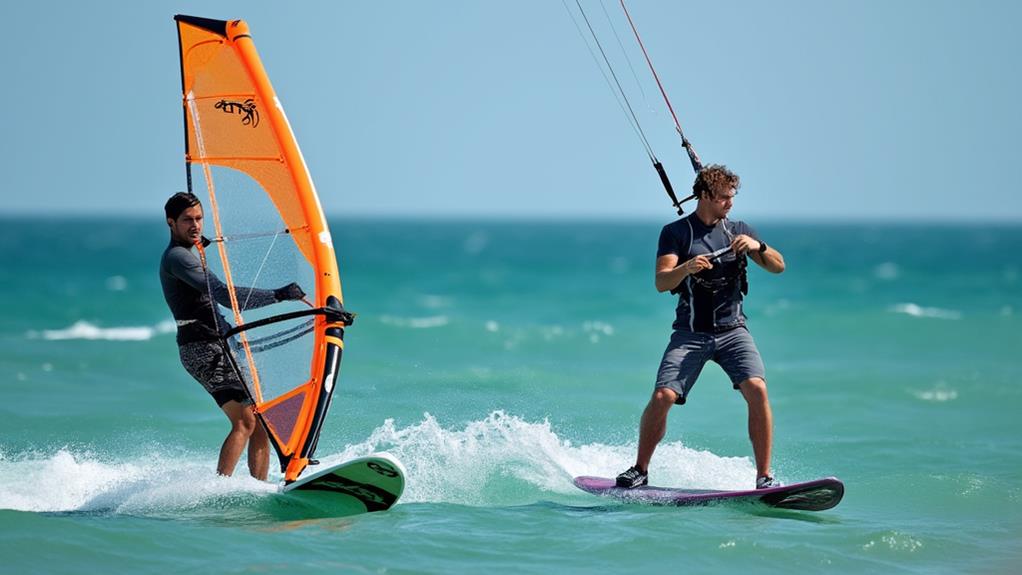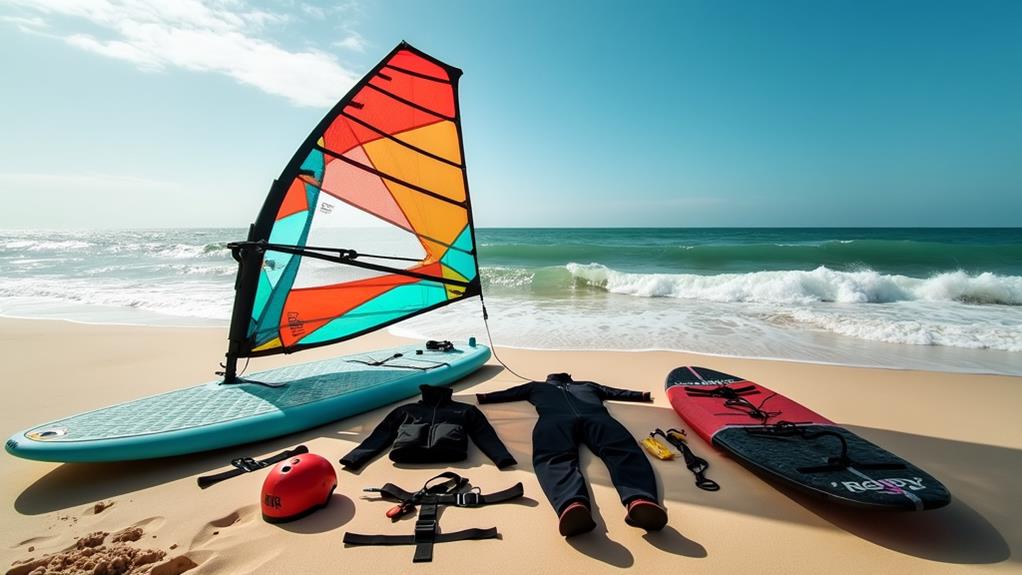Is Windsurfing Harder Than Surfing?
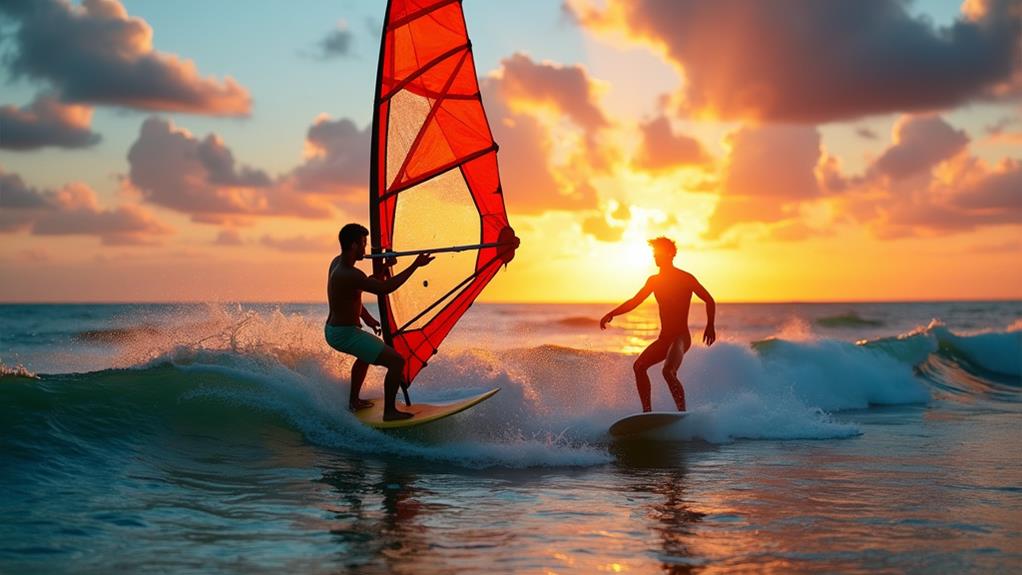
When considering whether windsurfing is harder than surfing, you need to examine the learning curve and physical demands. Surfing tends to offer quicker gratification, allowing you to catch waves relatively fast, whereas windsurfing often requires months of dedicated practice to master the basics. The physical demands also differ; windsurfing engages your entire body and emphasizes core strength, while surfing relies more on upper body strength and endurance. Additionally, the complexities of the equipment, costs, and environmental conditions play a significant role in determining the difficulty of each sport. Therefore, a comprehensive evaluation is necessary to understand which activity might be more challenging.
Learning Curve
Regarding the learning curve, windsurfing often presents a more challenging experience due to the combined demands of sail control and understanding wind dynamics. When you start windsurfing, you'll quickly realize that managing the sail while maintaining balance on the board isn't straightforward. Unlike other water sports, windsurfing requires you to grasp the complexities of wind direction and efficiently handle your equipment. These initial hurdles can make the learning process seem overwhelming and might even lead to early discouragement.
Surfing, on the other hand, tends to offer more immediate gratification. Catching your first wave is exhilarating and can happen relatively quickly compared to mastering windsurfing. However, this should not be mistaken for an easier endeavor; both sports require consistent practice to achieve proficiency. For windsurfing, you can expect about three months of dedicated practice before reaching a competent riding level. Surfing generally takes around six months to develop basic skills.
If you already have experience with sailing or surfing, transitioning to windsurfing will be smoother, but it still demands focused effort. The learning curve is steep, but with resilience, you'll gradually master the unique skills needed for this thrilling water sport.
Physical Demands
Surfing demands significant upper body strength and endurance, primarily for paddling out to catch waves. The journey through the surf to reach the peak alone requires substantial energy. Once there, catching waves and repositioning demands continuous physical effort, especially for beginners still mastering timing and balance.
In contrast, windsurfing engages the entire body. Core strength is vital for stabilizing on the board while managing the sail. This full-body engagement makes windsurfing a more comprehensive workout than surfing. Balancing against the wind's force adds an additional layer of physical challenge.
Despite their differences, both sports share certain physical demands. Surfing requires constant adaptation and balance due to the unpredictability of waves. Windsurfing calls for sustained core stability and balance, particularly in choppy waters.
Skill Development
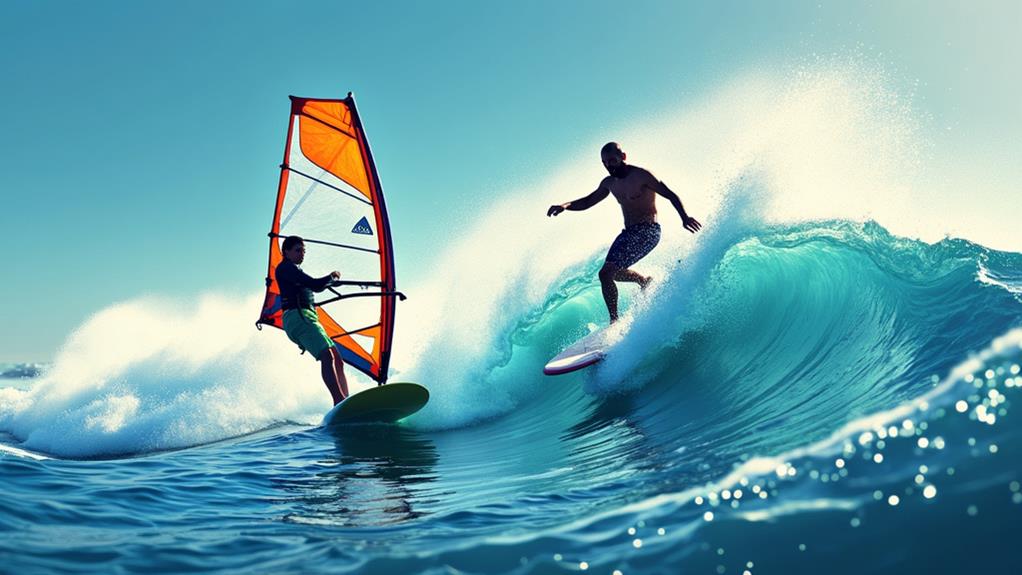
Windsurfing's steep learning curve can be intimidating due to the need to balance while managing the sail in varying wind conditions. Surfing typically takes about six months of consistent practice to grasp the basics, whereas windsurfing can often lead to riding proficiency in around three months with daily lessons. Both sports require dedication and resilience, though surfing's reliance on wave conditions might make early progress more frustrating.
Learning Curve Comparison
Mastering the basics of surfing and windsurfing involves distinct learning curves, each with its own set of challenges. Surfing typically requires about six months of consistent practice to grasp the fundamentals. In contrast, windsurfing can have you riding within a week of daily lessons in a windy location. However, windsurfing's learning curve is steeper due to the complexity of wind dynamics and sail management, making it a unique water sport.
Here's a quick comparison of the primary learning experiences for both sports:
- Surfing:
- Focuses on wave riding and balance.
- Requires mastering paddling, timing, and standing up on the board.
- Provides immediate gratification upon catching the initial wave.
- Windsurfing:
- Involves balancing and controlling the board while managing the sail.
- Has a steeper learning curve, especially in understanding wind dynamics.
- Becomes more intuitive with practice, enhancing enjoyment over time.
For both sports, continuous practice and feedback are crucial. Surfing may initially feel more frustrating due to the number of attempts needed to achieve results, but the immediate thrill of catching a wave can be incredibly rewarding. Windsurfing, while initially complex, offers a satisfying learning experience as you master the interplay between wind and water.
Practice and Progression
Building on the distinct learning curves of surfing and windsurfing, let's examine how practice and progression influence skill development in these sports. Surfing typically requires around 6 months of consistent practice, usually 3-4 days a week, to grasp the basics. In contrast, windsurfing might allow you to achieve basic riding skills within just one week of daily lessons in windy conditions. However, this rapid initial progress in windsurfing does not necessarily indicate that it is easier overall.
Surfing emphasizes mastering paddling and balance, offering immediate gratification when you catch your first wave. Achieving proficiency in surfing generally takes about 2 years. Windsurfing, with its steep learning curve, involves understanding wind dynamics and managing a sail, which can be initially challenging but also rewarding. Developing advanced windsurfing skills, such as riding without foot straps, might require up to 2 years of dedicated practice.
Both sports demand continuous practice and feedback for skill development. As you progress in windsurfing, a deeper understanding of wind conditions and techniques becomes essential. Whether you are riding waves in surfing or mastering the sail in windsurfing, your journey will be characterized by persistent practice and a gradual but rewarding progression.
Gear and Equipment
Windsurfing and surfing require different gear and equipment, reflecting the unique demands of each sport. For windsurfing, you'll need a board, sail, mast, and boom, making the gear more complex to transport and set up compared to the single surfboard used in surfing. Surfboards are lighter and easier to handle, offering greater convenience for quick beach sessions.
Transporting windsurfing gear can be challenging due to its bulkiness, often necessitating larger vehicles or specialized racks. In contrast, surfboards have simpler logistics and can be easily carried in smaller cars. Here are three key differences in gear and equipment for windsurfing and surfing:
- Components: Windsurfing requires multiple parts, including a sail, mast, and boom, while surfing only needs a surfboard.
- Portability: Surfboards are generally lighter and easier to transport, whereas windsurfing gear is bulkier and more cumbersome.
- Stability and Size: Windsurfing boards are wider and designed for stability, whereas surfboards vary in size and shape depending on wave conditions.
Both sports allow for personal customization. However, windsurfing equipment choices can significantly impact your learning and performance, requiring more research and investment compared to surfing gear.
Cost Differences
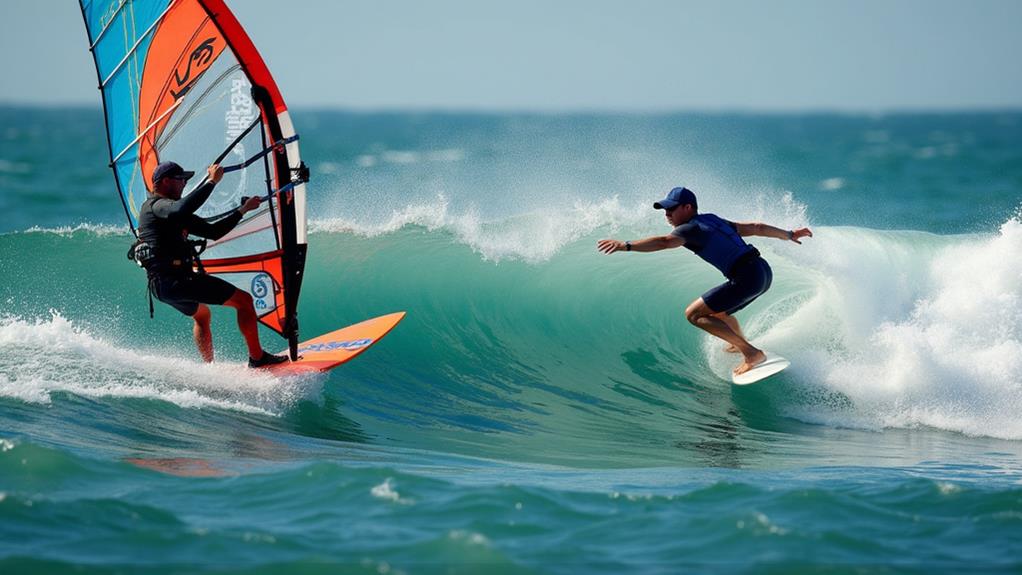
Surfing generally demands a lower upfront investment, with boards often priced under $750 and second-hand options around $300. In contrast, windsurfing requires several components like a board, sail, mast, and boom, leading to higher initial expenses. Additionally, maintenance and repair costs for windsurfing gear can be more substantial, making it a pricier sport overall.
Initial Equipment Investment
When starting your journey into water sports, you'll notice significant cost differences between windsurfing and surfing. Surfing is generally more budget-friendly regarding initial equipment investment. New surfboards can be found for up to $750, and second-hand options are available for around $300, making surfing an inviting choice for beginners.
In contrast, windsurfing requires a more substantial financial commitment due to the need for multiple components, including a board, sail, mast, and boom. This complexity drives up the total cost, making windsurfing a pricier option from the start. Here's a breakdown of initial costs:
- Surfing:
- New surfboard: up to $750
- Second-hand surfboard: around $300
- Windsurfing:
- Board: $1,000+
- Sail, mast, and boom: an extra $500-$1,000
- Storage and Transport:
- Surfing gear: compact and easy to manage
- Windsurfing gear: bulkier and requires more effort
The financial barriers for windsurfing are more significant, making surfing a more accessible and less intimidating option for newcomers. Therefore, if you're just starting out, the lower initial equipment investment for surfing might be more appealing.
Maintenance and Repair Costs
When evaluating the ongoing expenses of water sports, you'll find that surfing generally incurs lower maintenance and repair costs compared to windsurfing. Surfboards are relatively simple, with fewer components susceptible to damage. Typically, repairs are straightforward and affordable, ranging from $50 to $200 depending on the type and extent of the damage.
In contrast, windsurfing gear is more complex, comprising multiple elements such as sails, masts, and booms, each of which is prone to wear and tear. For instance, sail repairs or replacements can often reach several hundred dollars. This complexity typically results in higher maintenance and repair costs for windsurfing equipment, meaning you'll likely spend more time and money on upkeep.
Community and Lifestyle
Exploring the communities and lifestyles of windsurfing and surfing reveals distinct but equally passionate cultures. Windsurfing fosters a strong sense of community through active participation in local events and competitions, which offer enthusiasts opportunities to connect, share experiences, and savor the adrenaline of the sport. Support networks where experienced riders mentor newcomers are common, enhancing skill development and participation.
Surfing, deeply tied to coastal living and a laid-back lifestyle, contrasts with windsurfing's diverse crowd. Windsurfing attracts thrill-seekers on various water bodies. Social media groups and forums are popular platforms where enthusiasts exchange tips, gear recommendations, and personal stories, enriching the culture and making it accessible regardless of location.
Key aspects of both communities include:
- Local Events: Foster connections and community spirit.
- Mentorship Networks: Experienced riders guide newcomers.
- Digital Platforms: Forums and social media enhance engagement.
Both communities emphasize safety and preparedness, ensuring responsible enjoyment of the sport.
Safety Considerations

When assessing safety, surfing generally offers more predictability, particularly in familiar spots with stable waves, which helps reduce unexpected risks. Windsurfing, however, can be more hazardous due to unpredictable wind conditions and the potential for accidents during advanced maneuvers. Regardless of your choice, understanding local environmental factors and being prepared for emergencies are essential to minimizing the risk of injury.
Risk of Injury
Navigating the world of watersports requires understanding the potential risks and necessary safety measures. When comparing windsurfing and surfing, the risk of injury is a crucial factor. Windsurfing often carries a higher risk due to variable wind conditions that can lead to falls, crashes, and impacts with equipment. This is particularly true during advanced maneuvers like jumps and water starts, where the forces exerted on your body can cause neck and back pain.
In contrast, surfing injuries usually involve collisions with your board or other surfers, along with physical strain from paddling and riding waves. While both sports demand safety precautions, windsurfing requires a solid grasp of wind dynamics and local conditions to help minimize risks.
Here are three key safety tips to consider:
- Understand Wind Conditions: Knowing how to read and react to changing wind patterns can greatly reduce your risk of injury in windsurfing.
- Protective Gear: Wearing proper gear, such as helmets and impact vests, can help prevent injuries in both windsurfing and surfing.
- Local Knowledge: Familiarize yourself with local hazards and conditions to navigate the waters more safely.
Environmental Factors
Understanding environmental factors is fundamental for ensuring safety in both windsurfing and surfing. In windsurfing, unpredictable winds pose significant risks, with strong gusts potentially leading to sudden crashes, particularly during jumps or high-speed maneuvers. Knowing local wind conditions is crucial to mitigate these hazards, making it essential to check weather forecasts and understand how different wind speeds and directions impact your safety.
Surfing, on the other hand, tends to be safer in familiar areas where wave conditions are more predictable. Waves in popular surfing spots are often consistent, allowing you to better anticipate the water's behavior. However, injuries in surfing usually result from collisions with your board or other surfers, emphasizing the importance of spatial awareness and controlled movements.
Both windsurfing and surfing require knowledge of the environment. Surfing benefits from more consistent wave predictions, whereas windsurfing's safety protocols often call for additional training in equipment handling and understanding wind patterns, making it inherently more complex regarding environmental factors.
Ultimately, being prepared and aware of your surroundings is key. Whether maneuvering through waves or wind, understanding these environmental elements significantly improves your safety.
Emergency Preparedness
Emergency preparedness is crucial for windsurfing and surfing, ensuring you're equipped to handle unexpected situations effectively. Understanding local wind patterns is vital, as unpredictable winds can quickly turn a fun session into a dangerous one, especially for beginners. Wearing a personal flotation device (PFD) is not just recommended but required, providing buoyancy and safety in case of falls or equipment failures.
Knowing water rescue techniques and having a communication plan with others on the water significantly enhances safety. Here are three key steps to improve your emergency preparedness:
- Understand Local Conditions: Always check the wind and water conditions before heading out. Familiarize yourself with local wind patterns and potential hazards.
- Regular Equipment Checks: Inspect your gear carefully. Ensure your sail, mast, and board are in good condition to prevent accidents.
- Know Emergency Services: Be aware of local emergency services and their response times, particularly in unfamiliar locations. This knowledge can be lifesaving in a crisis.
Environmental Conditions
When examining environmental conditions, windsurfing and surfing exhibit distinct differences. Surfing is heavily dependent on wave conditions. Without good waves, your opportunities to surf are greatly limited, often confining you to coastal areas with consistent surf. This reliance on waves means that if the swell isn't right, you could find yourself out of luck and stuck on the shore.
In contrast, windsurfing offers more flexibility regarding environmental conditions. You don't need waves to enjoy windsurfing; all you need is wind and water. This allows you to practice windsurfing even on flat water days, providing far more opportunities to get on the water compared to surfing. For instance, in British Columbia, you can windsurf on over 20,000 lakes, each offering unique features and challenges not available for surfing.
Wind conditions are crucial for windsurfing success. Understanding local wind patterns becomes more vital than wave forecasting, which tends to be more critical for surfing. While surfers need to chase waves, windsurfers can take advantage of windy days, making windsurfing accessible in a wider range of environments.
Speed and Thrill
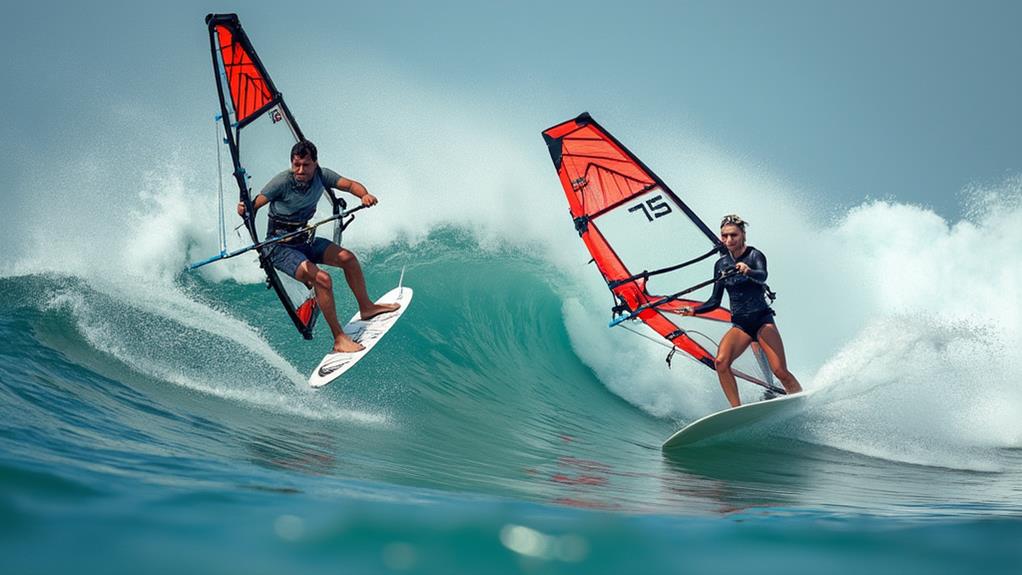
Windsurfing offers a level of speed and thrill that often surpasses traditional surfing. When conditions are optimal, you can zoom across the water at speeds up to 50 mph, making windsurfing one of the fastest water sports. This exhilarating pace contrasts sharply with surfing, where momentum depends on catching the perfect wave.
Key Factors Enhancing Speed and Thrill in Windsurfing:
- Extended Riding Time: Unlike surfing, where only about 8% of your session involves riding waves, windsurfing allows continuous riding as long as wind conditions are favorable. This means more time enjoying the speed and thrill.
- Foil Technology: Many windsurfing boards now feature foils, which reduce drag and enable faster gliding across the water. This innovation significantly enhances speed and thrill, catering to adrenaline seekers.
- Higher Speed Potential: The fusion of sailing and surfing in windsurfing allows for higher speed potential. While surfers depend on wave size, windsurfers harness wind power, making it possible to achieve exhilarating high speeds.
Accessibility and Transport
Transporting and accessing gear for surfing and windsurfing differ considerably, impacting each sport's practicality. Surfing requires a relatively simple setup: a lightweight surfboard. This simplicity allows for easy transportation in a car, making it more accessible for catching waves at various coastal locations.
In contrast, windsurfing gear is more complex and bulkier, comprising a board, sail, mast, and boom. This complexity makes transportation more challenging, often necessitating additional space and specialized racks or trailers. Managing the weight is also a consideration, as windsurfing boards are sturdier and heavier than the lighter, more fragile surfboards.
Accessibility differs as well. Surfing is generally best suited for coastal areas with consistent waves. Windsurfing, however, offers more flexibility since it can be practiced in any location with adequate wind and water. This flexibility comes at the cost of more complex gear handling. Therefore, while windsurfing provides varied location options, the additional transport and setup can be cumbersome.


